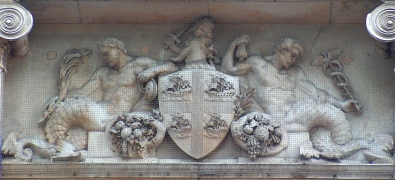
A couple of mermen are illustrated on the mermaids page on this site, but here is a page particularly on mermen and Tritons, this latter word referring particularly to the twin-tailed variety. Above are a typical pair of 19th Century mermen. They have the chest, neck, and muscular arms of a Roman gladiator, changing at hip level into two sinuous, twisting tails. The Roman look of the one on the left is accentuated by the style of hair and beard, which reminds us of statues and portrait busts of Hadrian and other emperors. The cornucopias on which they rest, though filled with produce of the harvest in the usual way, look more like shells than horns. The scales begin at leg level, and in this example are well delineated, almost spiny. Here, there is no suggestion of an upper leg – the twin tails immediately start to bend and flex emphasising that there is no underlying thigh or kneebone.
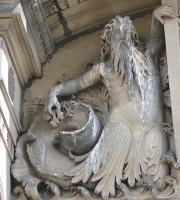
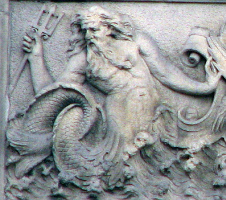 Sculptures of twin-tailed Tritons.
Sculptures of twin-tailed Tritons.
Above left is another example of the twin-tailed Triton type, though one tail is underwater below the ‘thigh’. Here, the surround is much more aquatic, the merman rising out from the choppy waves of the sea, and behind him and draped over his tail are strands of seaweed. He is of what we may call the Neptune rather than the Roman type, with long, weedy hair and tentacle-like beard covering much of his chest. At waist height he has a skirt of indeterminate frondsk or fins. Above right, rather a poor picture, we have a similar merman, Neptunelike to the point of holding a short trident. The tentaclelike nature of his tails is stressed by the visible one being entirely looped round in a knot.
Here we have a merman by the sculptor W. G. Nicholl, by St George’s Hall Liverpool. He sits upright, holding a cornucopia, and once, we may presume, a lamp. The classical head, trimmed beard and wreath in his hair puts him firmly in the Roman camp. Again twin-tailed, with delicate finny skirt, unlike the previous examples he has clear upper legs, with a human thighs and knees, before the lower legs becomes tails. Above centre is an ornamental merman, shaved and of a Greek rather than Roman ideal. Again he has knees, and the proportion of the thigh is correct for a human, but in a concession to fishiness, there is a curvature beyond what we would find in a man. The small size means that the sculptor has not included scales, and he is entirely nude without a kilt or skirt. And above right, an ornate merman acting as a corbel. With wild beard and moustache, and writhing twin tails, he even has a pair of wings.
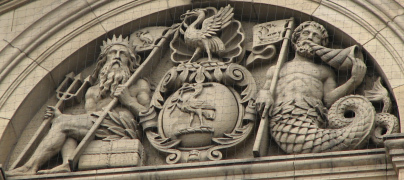
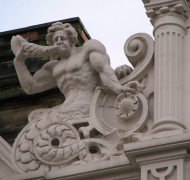 Mermen with long, flexible tails.
Mermen with long, flexible tails.
Now to single-tailed mermen. Above left, a merman and a Neptune, in a coat of arms for Liverpool. The coiled tail of the merman nicely fills the corner of the almost triangular space above a portico, but the immediate curvature below the waist makes his upper portion look disproportionate to the tail, despite the length of the latter. The scales are prominent, and to mask the juncture of fish tail and human stomach is a belt of leaves. He is of Roman type, and holds a horn to his lips, his other hand holding a flag. Above right, high on a building, is a crudely rendered merman, again blowing a horn, and with coiled tail. He is shown hugely over-muscled in the arms, excusable only because the height above ground level means that individual features need to be exaggerated to be clearly observed by the passer-by.
Here is an interesting variation of the femme fatale – a merman and a nymph, he being of the Neptunelike type with long, flowing beard. Although his expression is stern and he grasps the nymph possessively by her slender wrist, we have the clear sense that he is more captivated by her than the reverse; she is seated on his upper body as if her were a beast of burden, smoothing his brow with her free hand, and wearing a coquettish, almost amused expression.
So much for Victorian early 20th Century mermen. The genre was revived after the First World War and through to the 1930s in a style that commenced in Edwardian, art nouveau times, in the type shown above. Here youthful, boyish mermen, very different from their bearded Neptunelike or Roman emperorlike precursors. Note their helmets made out of seashells.
Two more panels of this type. Above left is a group of two mermen of art deco form, holding between them a shell enclosing a half kneeling Aztec-style figure of Neptune. The mermen have the waist-fins we have seen before, and carry short tridents. Their faces are smooth, their musculature stylised to leave only outlines. Above right is another smooth-faced, short haired merman from a war memorial. Only half is shown in the small picture (click to see the whole body, with its twin tails. He is shown swimming, and blowing a conch. Below is a symmetrical composition of a twin-tailed youthful merman of similar sort, with a boyish physique, holding two fish.
We end by jumping back to earlier in the Century, to a group of mermen and a mermaid, the males being clean-shaven, twin tailed with the more human-like lower limbs with distinct knees. This splendid group, by the sculptor Henry Poole, forms one of the principal decorative sculptures on Cardiff Town Hall. Another group by the same sculptor, in Bristol, is described on this page.
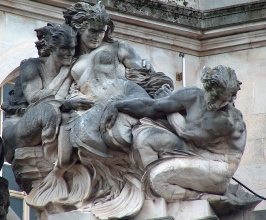 Mermen and mermaid, by Henry Poole, Cardiff Town Hall.
Mermen and mermaid, by Henry Poole, Cardiff Town Hall.
Visits to this page from 13 Mar 2014: 13,291
Sculpture pages // Mermaids // Angel Statues // Statues of Warrior Women // Sphinx Statues // Cherubs